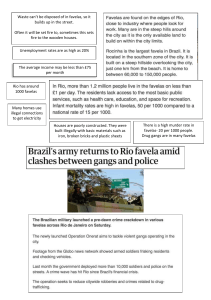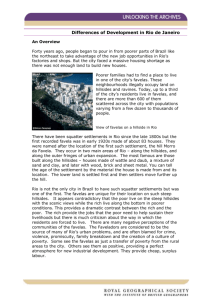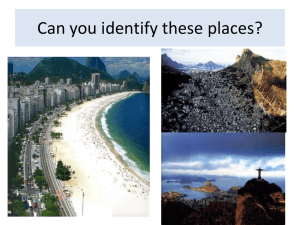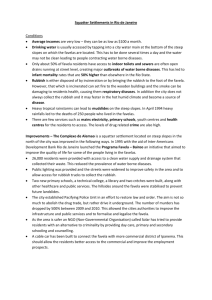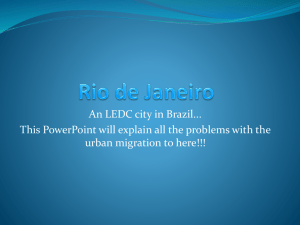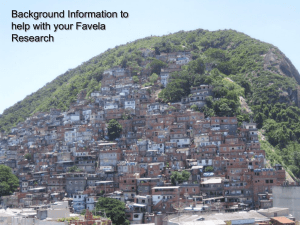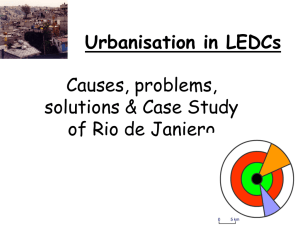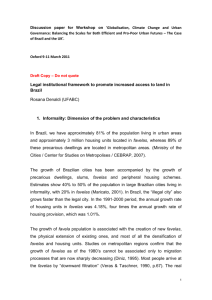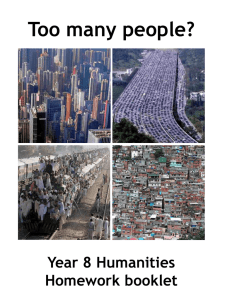Urban Housing the poor ROCINHA
advertisement
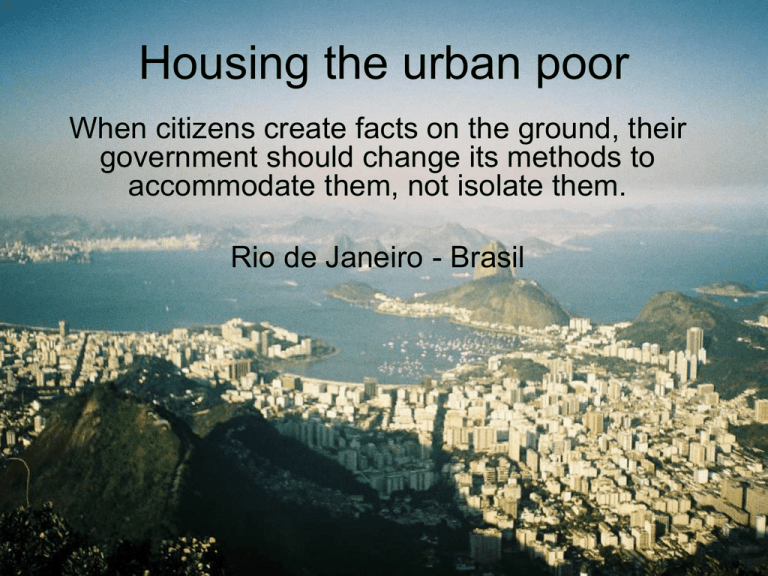
Housing the urban poor When citizens create facts on the ground, their government should change its methods to accommodate them, not isolate them. Rio de Janeiro - Brasil Rural to urban migration Still a factor in growth of Rio, but natural increase of city pop, particularly lower income groups, now the main factor. Rocinha View from Rocinha looking towards Zona Sul Rocinha 750 favelas in Rio. But new ones still being established. 20% of Rio’s pop live in favelas. 33% of world’s urban pop live in spontaneous settlements. Housing in Rocinha 2001 Census – pop 60,000 But over 100,000 legally registered electricity meters. Estimated pop 200,000. Rocinha started 1940s, Every neighbourhood required domestic servants and labourers who lived in nearby favelas. No policing of these areas. 1950s drought in NE brazil led to rural to urban migration, 1960s construction boom in Rio attracted workers. Favelas integral part of Rio. Older favelas located centrally. Rio’s first favela established in 1888 by government troops (ex slaves) who returned to Rio after defeating a Royalist uprising in NE Brazil. They were given no housing on their return and camped on Morro Providencia Only one road through the favela. Most of Rocinha is a maze of narrow alleyways Favelas are not illegal settlements. In Rio there are squatters rights on public land. The right to build and own a house. After 10 years of ownership the squatter can start procedure to obtain title of the land. 1950s and 60s. More space needed in central Rio. Favelas cleared to make way for new developments. New housing built for favela residents on edge of city. City of God near Barra da Tijuca. But no shops, services, employment, public transport. People took toilet, sink and water tank and moved back into central favelas. During the period of forced evictions from favelas, the residents of favelas resisted. The police moved them during the day, they moved back at night. In Vidigal residents resisted using force. Eventually the authorities stopped trying to move people from favelas. In 1994 favelas were first included on official maps of the city. An acceptance that they exist. 1995 Favela Bairro Plan. Accept that favelas exist and try to normalise and integrate them through provision of sewage, water and rubbish collection. Electricity companies had been supplying favelas since 1970s. High demand, easier to set up, residents use bills as proof of residency and ownership. Recent focus on speeding up legalisation process. Property value doubles after legalisation. Tax paid but also possibility to realise the value of the asset. Not all electricity use is paid for… “Making a cat” Wiring up electrical cables. The blue cables are boardband Internet Rocinha’s central location means it functions as a low cost residential area. The newer favelas which are in Rios sprawling North Zone do not benefit from that centrality. Favelas have strong social fabric based on original rural migrants and extended families 1300 licensed shops Many informal shops 3 schools 5 radio stations 3 newspapers 1 cable TV company 3 bus services Garbage collection Moto taxis 3 bank branches 2 health centres 1 police point with 2 police With large barriers to entry to the formal sector such as lack of access to credit and bureaucracy, most enterprises are in the informal sector. Post office and health centre in Rocinha. Basic diagnosis and vaccinations especially TB. The Lula government’s Bolsa familia scheme gives money to families if their children have 80% school attendance and have vaccinations. A branch of a bank in Rocinha One of the banks in Rocinha was attacked and robbed. The robbers were off-duty police who thought that they could get away with robbing a bank in a favela. The drugs gangs now protect the bank If you have no legal address you can collect your post from here. Rent DVDs from Rocbuster Political posters. There are many more poor people in Brazil than rich people. That’s a lot of votes. But Rocinha, like 300 other favelas in Rio, is controlled by a drugs gang. The laws of the drugs gang are to ensure disputes between residents don’t disturb business, they have the support of the community and the police stay out. No rape, assault, or mugging No stealing within the favela No talking to the police First offence = beating or hand shot Second offence = death Drugs are sold on the edge of the favela. Police are positioned directly outside the favela but do not enter. If they did, heavily armed members of the gang would shoot at them. Members of drugs gang openly carry weapons. The leaders of the drugs gang are in their twenties, but would have started their career at the age of 6 as delivery boys or kite flyers. Red kite = police invasion Green kite = delivery of Cannabis White kite = delivery of cocaine Firecrackers also used In 2006 Amigos do Amigos (drugs gang) spent 1.5 million US$ on Rocinha’s samba school carnival float. Children’s day was celebrated with a big street party for kids. The drug lord’s birthday was celebrated with continuous gunshots throughout the night. In the 1970s political prisoners were mixed with common criminals in Ilha Grande prison. The political prisoners taught their fellow inmates guerilla warfare tactics. The criminals used these skills to form hierarchical, imperialist drugs gangs in the favelas. Comando Vermelho (CV), Terceiro Comando (TCP), Amigos dos Amigos (ADA) In April 2004 the Vidigal’s TCP invaded CV controlled Rocinha with 100 armed gang members. One month of gang warfare. The police went into Rocinha. CV was unable to fight both the TCP and the police so they asked for help from ADA. CV leader was killed and ADA took over Rocinha. Police incursions into the favelas are very problematic. The police in their uniforms are easily identifiable targets. The maze of narrow alleys make orientation and target tracking difficult. Police have problems differentiating between residents and gang members. Innocent people often killed. The residents of favelas in Rio live in a parallel existence with residents of Rio’s other increasingly “gated” neighbourhoods. The faveladores work in mainly in low paid jobs supporting the city’s economy and yet the city is unable or unwilling to supply them with basic urban services or security. The faveladores are left to co-exist with criminal gangs whose own form of social justice and control is motivated by the needs of their drugs businesses and not the needs of the people. The president of Rocinha The school the president had built Housing in Villa Canoas A small favela supported by the Rotary Club of Turin Playground in Villa Canoas New housing on the edge of the Cidad de Deus Cidad de Deus Spontaneous settlements process of development • http://www.sln.org.uk/geography/geoweb/b lowmedown/shanty05.swf
